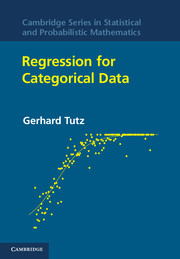Book contents
- Frontmatter
- Contents
- Preface
- 1 Introduction
- 2 Binary Regression: The Logit Model
- 3 Generalized Linear Models
- 4 Modeling of Binary Data
- 5 Alternative Binary Regression Models
- 6 Regularization and Variable Selection for Parametric Models
- 7 Regression Analysis of Count Data
- 8 Multinomial Response Models
- 9 Ordinal Response Models
- 10 Semi- and Non-Parametric Generalized Regression
- 11 Tree-Based Methods
- 12 The Analysis of Contingency Tables: Log-Linear and Graphical Models
- 13 Multivariate Response Models
- 14 Random Effects Models and Finite Mixtures
- 15 Prediction and Classification
- A Distributions
- B Some Basic Tools
- C Constrained Estimation
- D Kullback-Leibler Distance and Information-Based Criteria of Model Fit
- E Numerical Integration and Tools for Random Effects Modeling
- List of Examples
- Bibliography
- Author Index
- Subject Index
10 - Semi- and Non-Parametric Generalized Regression
Published online by Cambridge University Press: 05 June 2012
- Frontmatter
- Contents
- Preface
- 1 Introduction
- 2 Binary Regression: The Logit Model
- 3 Generalized Linear Models
- 4 Modeling of Binary Data
- 5 Alternative Binary Regression Models
- 6 Regularization and Variable Selection for Parametric Models
- 7 Regression Analysis of Count Data
- 8 Multinomial Response Models
- 9 Ordinal Response Models
- 10 Semi- and Non-Parametric Generalized Regression
- 11 Tree-Based Methods
- 12 The Analysis of Contingency Tables: Log-Linear and Graphical Models
- 13 Multivariate Response Models
- 14 Random Effects Models and Finite Mixtures
- 15 Prediction and Classification
- A Distributions
- B Some Basic Tools
- C Constrained Estimation
- D Kullback-Leibler Distance and Information-Based Criteria of Model Fit
- E Numerical Integration and Tools for Random Effects Modeling
- List of Examples
- Bibliography
- Author Index
- Subject Index
Summary
Most of the models considered in the previous chapters are members of the generalized linear models family and have the form g(μ) = xT β, with link function g. The models are nonlinear because of the link function, but nonetheless they are parametric, because the effect of covariates is based on the linear predictor η= xT β. In many applications, parametric models are too restrictive. For example, in a linear logit model with a unidimensional predictor it is assumed that the response probability is either strictly increasing or decreasing over the whole range of the predictor given that the covariate has an effect at all.
Example 10.1: Duration of Unemployment
When duration of unemployment is measured by two categories, short-term unemployment (1: below 6 months) and long-term employment (0: above 6 months), an interesting covariate is age of the unemployed person. Figure 10.1 shows the fits of a linear logistic model, a model with additional quadratic terms, and a model with cubic terms. The most restrictive model is the linear logistic model, which implies strict monotonicity of the probability depending on age. It is seen that the fit is rather crude and unable to fit the observations at the boundary. The quadratic and the cubic logistic models show better fit to the data but still lack flexibility. Non-parametric fits, which will be considered in this chapter, are also given in Figure 10.1. They show that the probability of short-term unemployment seems to be rather constant up to about 45 years of age but then strongly decreases. The methods behind these fitted curves will be considered in Section 10.1.3.
- Type
- Chapter
- Information
- Regression for Categorical Data , pp. 269 - 316Publisher: Cambridge University PressPrint publication year: 2011

